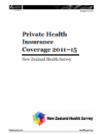Individuals with private health insurance (PHI) may have more timely access to non-urgent treatment than those without insurance.
This report presents findings about the PHI of adults and children from data collected between 2011 and 2015 in the New Zealand Health Survey. The report details the proportion of people in New Zealand who reported having PHI cover (across different population groups, such as age, sex, ethnicity, neighbourhood deprivation, household income and district health board), how this has changed over time and who pays for the PHI.
Key Results
- More than one-third of adults (35%) and 28% of children were covered by PHI.
- PHI coverage was highest for the age groups between 35 and 64 years (35–44 years, 41%; 45–54 years, 42%; 55–64 years, 41%) and lowest for those aged 75 years and over (16%).
- Māori and Pacific people were less likely to report having PHI cover than non-Māori and non-Pacific people, respectively, after adjusting for age and sex differences.
- After examining a range of demographic and socioeconomic factors, household income was found to have the strongest association with PHI coverage.
- There was variation in PHI coverage for adults between district health boards (DHBs), with highest coverage in Auckland (45%), Waitemata (43%) and Canterbury (40%).
- The proportion of adults with PHI coverage has decreased from 40% in 1996/97 to 35% in 2011–15. For children, coverage has decreased from 31% in 1996/97 to 28% in 2012–15.
- Most adults (79%) with PHI cover report that they either pay for the PHI themselves or it is paid by a family member.

